Tarragona ★
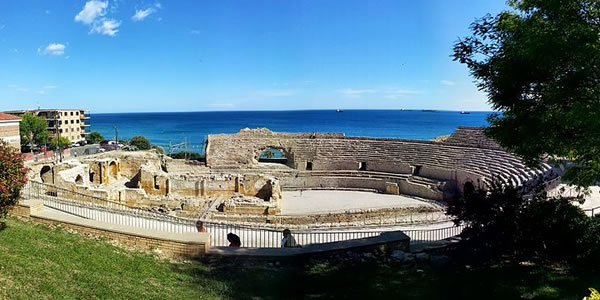
The AD 2nd century Romapn Amphitheater of "Tarraco" in Tarragona. (Photo by Mark Thurman)
The best Roman ruins in Spain lie on the coast outside Barcelona
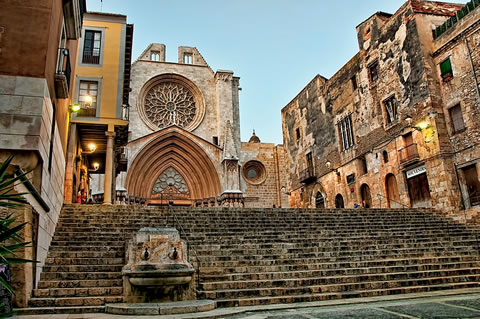
The facade of Tarragona's Cathedral of Santa Maria. (Photo by Carme Ribes Moreno).Tarragona—or, rather, "Tarraco" at the time—was the Roman Empire's base of operations during its conquest of the Iberian peninsula beginning in 218 BC. Julius Caesar himself even bivouacked here for a while.
Though it boasts Spain's best Roman ruins, including a crumbling seaside amphitheater, Tarragona is still a scandalously under-visited destination.
Below are just the highlights; other bits and bobs of ancient Rome lie scattered around town. You can get details on them at the websites of the two orginizations that, between them, run most of the archaeological sites and museums in town: www.mnat.cat and www.museutgn.com.
The Roman Ampitheater at Tarragona ★★
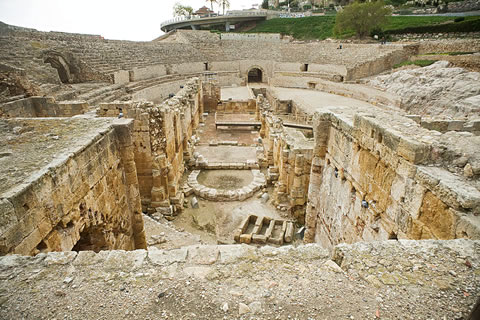
The inner workings of the ancient Roman amphitheater at Tarragona. (Photo by Paul M.R. Maeyaert).Near the modern harbor, just south of the old city, a stretch of the Mediterranean shore has been converted into a park to commemorate the ruins of the AD 2nd century Amfiteatre Romà (Roman Amphitheater), carved directly out of the beachside cliff.
The scenically crumbling oval of stony seats—at 109.5m (359 feet) long and 86.5m (284 feet) wide—once held up to 1,400 fans screaming for blood at gladiatorial matches and public executions.
In fact, a few early chruch martyrs were ceremonially burned on this site, including the 3rd century Bishop Fructuoso. The Visigothic basilica built right on top of the site was replaced in the Middle Ages by the church of Santa Maria del Miracle, the low walls and roofless remains of which just right into the center of the amphitheater.
The main entrance to the Parc de l'Amfiteatre is on the SE corner of the traffic circle wihere Rambla Vella, Carrer Via Augusta, Passeig de Sant Antoni, and Via William J Bryant meet. Take bus 1 or 9 to "Balcó" on Carrer Via Augusta, or bus 8 or 21 to "Pilats" on Passeig de Sant Antoni (tel. +34-977-242-579, www.museutgn.com).
The ancient amphitheater is open April to September, it's open Tuesday to Saturday 9am to 8pm, Sunday 9am to 3pm. October to March, it's open Tuesday to Saturday 9am to 5:30pm, Sunday 9am to 3pm. (Adm)
The Archaeological Museum of Tarragona ★★
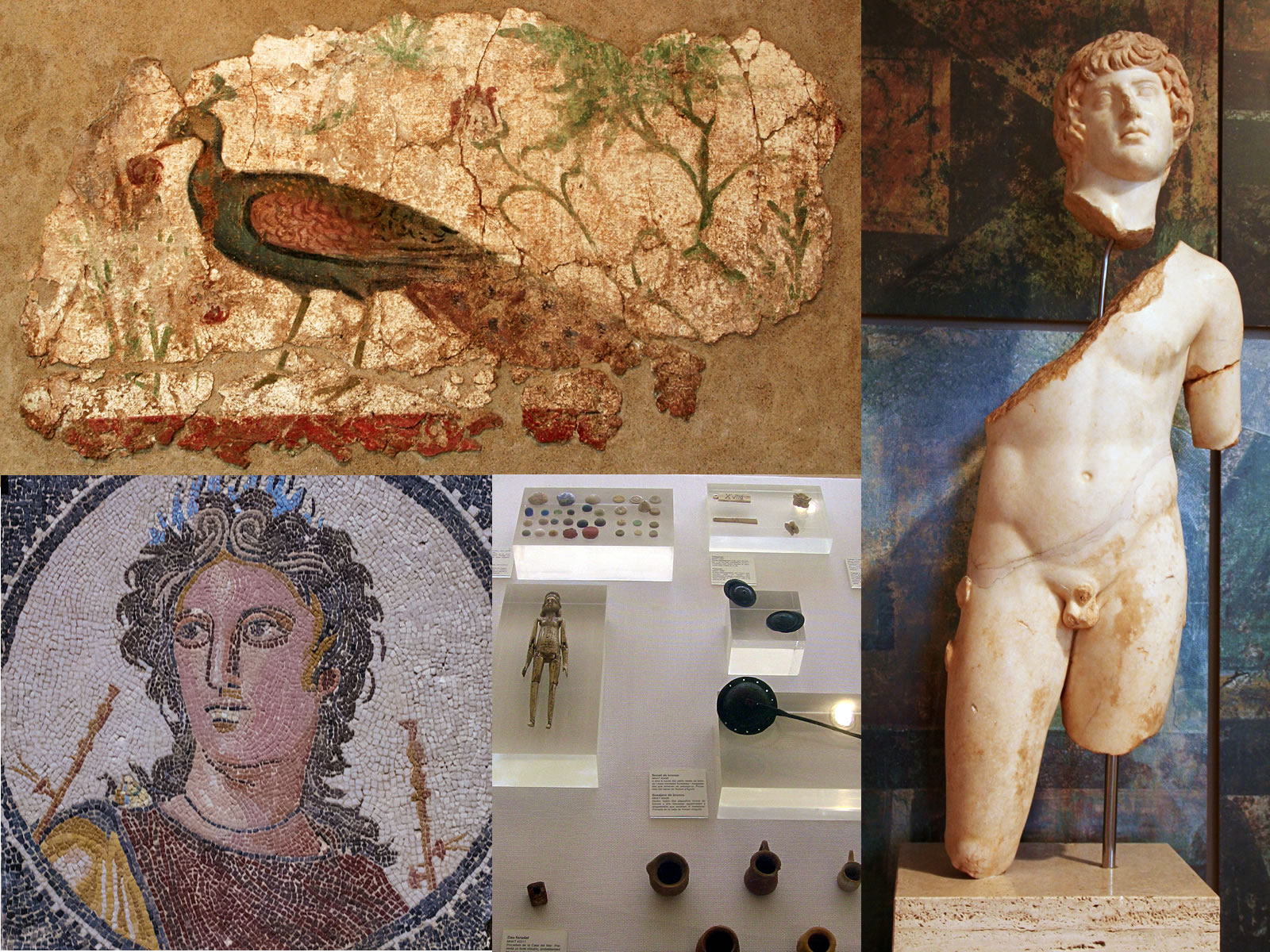
Exhibits in the Tarragona Archaeological Museum: Peacock fresco, AD 2C/3C; Antinoo sculpture, AD 2C (Photo by Ophelia2); Ancient Roman toys (Photo by Montrealais); Euterpe mosaic, AD 2C (Photo by Caroline Léna Becker).A few blocks north of the Roman amphitheater, the Museu Nacional Arquològic (Archaeological Museum) contains Catalonia's biggest collection of Roman sculpture, some rare and lovely frescoes, bronzes, and a bevy of mosaics, including a magnificent early 3rd century AD Mosaic of the Fishes, and AD 2nd/3rd century mosaics of the Medusa myth.
The museum is at Plaça del Rei 5, just off Passeig de Sant Antoni; bus 8 or 21 to "Pilats" (tel. +34-977-236-209; www.mnat.cat).
It is open June-Sept Tues-Sat 9:30am–8:30pm, Sun 10am–2pm; Oct-Apr Tues-Sat 9:30am–6pm, Sun 10am–2pm.
Walking the ancient walls of Tarragona ★
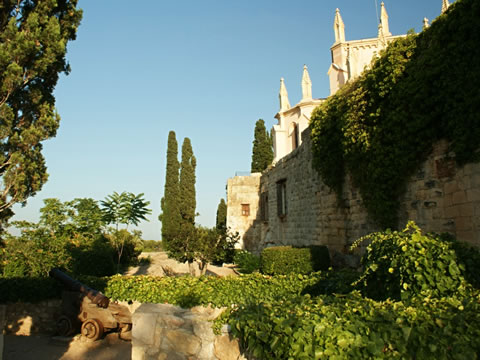
The Roman-era walls of Tarragona. (Photo by Ferran LLorens).Tarragona is a modern industrial center, but this port city's origins are ancient, as evidenced by the 3rd century BC walls that curl around the city's eastern edge.
The Romans built their own fortifications atop this protective belt of Cyclopian stone, medieval Catalonians further reinforced them, and the Brits topped it off with new ramparts in the 17th century.
The cypress-shaded Passeig Arqueológic, or architectural path around the walls makes a nice half-mile walk (tel. +34-977-245-796, www.museutgn.com).
The main entrance to the wall walk is at the west-northwestern entrance to the old city, on the outside of the wall just beyond Pl. Pallol where Av. Cataluyna ends at the Portal de Roser city gate; bus: 22.
The wall walk is open Apr 19–Sept 30, Tues-Sat 10am-9pm, Sun 10am–3pm; Oct-Apr 18, Tues-Sat 10am–7pm, Sun 10am–3pm. (Adm)
The medieval cathedral of Tarragona ★
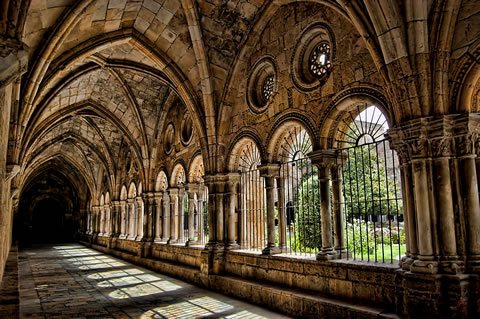
The cloisters of the Tarragona cathedral. (Photo by Carme Ribes Moreno).The walls encircle the oldest part of town and the 12th-century Catedral de Santa Maria, built on the site of a Roman temple.
Stained-glass windows illuminate the interior, which sports an alabaster altarpiece (1430) honoring St. Tecla.
The beautiful, orange tree-shaded cloisters, like the rest of the cathedral, show how seamlessly the architecture of this church slipped from its Romanesque beginnings into a vaulted, Gothic finale.
Off of the cloisters is a small museum of tapestries and medieval sculpture.
The cathedral of Tarragona is on Pl. de la Seu (tel. +34-977-226-935; www.catedraldetarragona.com).
It is open Jun–July 28, Sep 15–Nov 4, and Easter season daily 10am–7pm; July 29–Sept 14 Mon-Fri 10am–8pm, Sat 10am–7:30pm; Nov 5–Mar Sun-Fri 10am–2pm, Sat 10am–7pm. (Adm)
The model of Tarraco
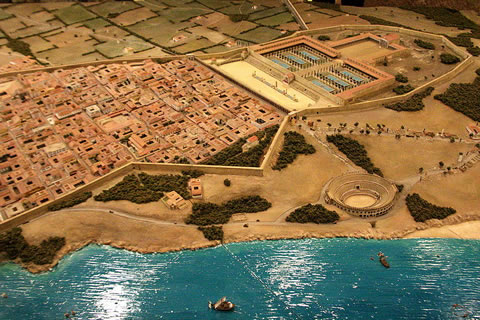
The model of Roman Tarraco in Tarragona (Photo by Amadalvarez).You can see a scale model of the Roman-era "Tarraco" in a small museum called the Pallol Vault—actually part of the the colonnade surrounsing surroudning the old Roman Forum—in the northwestern part of the old city at Pl. del Pallol (www.museutgn.com); bus 22 to "Portal de Roser" then through the city gate.
It is admission-free, and open Mon–Fri 9am–9pm, Sat 10am–9pm (it closes at 7pm in winter).
The Necropolis

The Tarragona Paleochristian Necropolis and its museum. (Photo by Fernando Fernández Baliña)On the western edge of town—just south of Av. de Roma between the Parc de la Ciutat park and little Riu Francoli river—lies a 3rd- to 6th-century Paleochristian Necropolis (Tel. +34-977-251-515; www.mnat.cat) at Av. Ramón y Cajal 84; bus 42 to "Complex Educatiu."
The little museum here houses—and, indeed, is surrounded by—ancient Christian tombstones and sarcophagi—many of them recycled from even older pagan tombs.
It's open June-Sept 10am–1:30pm and 4–8pm, Mar-May and Oct 9:30am–1:30pm and 3–6pm, Nov-Feb 9:30am–1:30pm and 3–5:30pm. (Adm)
Where to eat in Tarragona
If hunger hits you, check out Barquet (tel. +34-977-240-023; www.restaurantbarquet.com), at Gasòmetro 16, for excellent Catalán seafood and a variety of fixed-price menus ranging from €27 to €42.50.
Where to stay in Tarragona
Should you choose to spend the night, the Hotel Lauria (tel. +34-977-236-712, www.dormicumhotels.com; ![]() ), at Rambla Nova 20, rents modern doubles for just €49–€66 in the heart of town, just off the seafront promenade, with free WiFi and an outdoor pool.
), at Rambla Nova 20, rents modern doubles for just €49–€66 in the heart of town, just off the seafront promenade, with free WiFi and an outdoor pool. ![]()
I also like Hotel Plaça De La Font (tel. +34-977-246-134, hotelpdelafont.com; ![]() ), at Plaça de la Font 26 between Rambla Vella and Carrer Sant Domènec, with bright, modern rooms in the Old City, a short walk from most of the sights in town, with doubles for around €55.
), at Plaça de la Font 26 between Rambla Vella and Carrer Sant Domènec, with bright, modern rooms in the Old City, a short walk from most of the sights in town, with doubles for around €55. ![]()
Find more places to stay in Tarragona: Booking.com, Venere.com, Airbnb.com.
Tips & Links
Tarragona is a mere hour's train ride from Barcelona on the main line to Madrid (trains leave Barcelona from the Sants station, but many call at Franca and/or Passeig de Gràcia stations first).
When you're in Tarragona, city bus 21 runs you from the train station pretty close to the amphitheater then makes a circuit of the old city walls , then up Carrer Via Augusta past the amphitheatre (emtanemambtu.cat).
The tourist office has a good PDF map you can download.
Planning your day: You can see the top sights in two to three hours, take a leisurely stroll along the ancient walls, and then enjoy a picnic in their shadow—and call it all a half-day excursion.» Barcelona itineraries
On Mondays, most sights in town are closed.
The only things that remain open are the Cathedral and its museum, the Model of Roman Tarraco, and the Paleochristian complex by the Francolí River.
On Tuesdays, several sights in town becoe admission-free, including the archaeology musuem and the necropolis (basically anything run by www.mnat.cat).
Here are tours from our partners that visit Tarragona:
- Tarragona and Sitges Small Group Day Trip from Barcelona
- Tarragona and Sitges Private Day Trip from Barcelona
- 2-Day Southern Catalonia Tour: Sitges, Tarragona and Santes Creus
- 4-Day Best of Catalonia Tour from Barcelona
- Catalonia 5-Day Trip from Madrid: Barcelona, Montserrat, Vic, Girona, Figueres, Tarragona and Sitges
SIGHTS
Barcelona tourist info: Barcelonaturisme.com (info office), Guiadelocio.com (events mag); Catalunya.com (regional info), Spain.info
Sightseeing passes: Barcelona Card (20+ sights; transport; discounts), Museum Pass (6 sights)
Tours & activities: Viator.com, ContextTravel.com, UrbanAdventures.com, City-Discovery.com, Intrepidtravel.com, Gadventures.com
LODGING
Hotels: Booking.com, Venere.com, Priceline.com, Hotels.com
B&Bs: Booking.com, Bedandbreakfast.com, Airbnb.com, Venere.com
Apartments: Rentalo.com, Vrbo.com, Booking.com, Airbnb.com, Interhomeusa.com, Homeaway.com
Hostels & campgrounds: Hostelbookers.com, Hostelworld.com, Hostelz.com, Booking.com
TRANSPORT
Airfares:
Airports: Aena.es
Trains: Raileurope.com (throughout Europe), Renfe.com (within Spain), Bahn.de (throughout Europe), Seat61.com
Public transport: Barcelona Card (free transport; sightseeing); Search all public transit: mou-te.gencat.cat; Metro/Bus: Tmb.cat; Tram: Trambcn.com; Light rail: Fgc.cat; Taxi: Taxibarcelona.cat
Car rentals: Autoeurope.com, RentalCars.com, Momondo.com, Orbitz.com, Expedia.com, Travelocity.com, Kayak.com
Leave the driving—and the guiding—to someone else with an escorted or guided daytrip. True, you're usually with a small group, but this is by far the best way to fit the most into a short amount of time.
- Montserrat
- Girona, Figueres, & Costa Brava
- Pyrennes, Tarragona, & Catalan villages
- Food & wine
- Multi-day excursions
- Barcelona Super Saver: Montserrat Day Trip and Barcelona Gaudi Tour
- Montserrat and Cava Trail Small Group Day Trip from Barcelona
- Montserrat Royal Basilica Half-Day Trip from Barcelona
- Barcelona and Montserrat Small-Group Tour
- Barcelona Super Saver: Sightseeing Tour with Montjuic Cable Car and Montserrat Tour
- Barcelona Day Trip: Montserrat, Colonia Guell and Gaudi Crypt
- Barcelona Super Saver: Sitges, Freixenet Cava Wine Cellars and Montserrat Tour
- Montserrat and Cava Trail Small Group Day Trip from Barcelona
- Small-Group Tour: Traditional Food and Wine Day Trip from Barcelona
- Small-Group Cava and Wine Day Trip from Barcelona
- Barcelona Super Saver: Sitges, Freixenet Cava Wine Cellars and Montserrat Tour
- Barcelona Super Saver: City Tour, Sitges and Freixenet Cava Day Trip
- Catalan Culture Tour from Barcelona: Food Market, Montblanc and Human Tower Festival
- Sitges and Freixenet's Cava Wine Cellars Day Trip from Barcelona
- Private Full Day Tour to Sitges and Bodegas Torres
- 4-Day Best of Catalonia Tour from Barcelona
- 6-Day Spain Tour from Barcelona: Zaragoza, Madrid, Cordoba, Seville, Granada and Valencia
- 8-Day Spain Tour Including Barcelona, Madrid, Cordoba, Seville, Granada and Toledo
- 5-Day Spain Tour: Cordoba, Seville, Granada and Toledo from Barcelona
- 2-Day Northern Catalonia Tour: Vic, Figueres, Girona and Montserrat
- 2-Day Southern Catalonia Tour: Sitges, Tarragona and Santes Creus

Related Articles
- Barcelona sidetrips
- Barcelona sights
- Barcelona experiences
- Barcelona homepage
- Spain planning FAQ
- Spain homepage
This article was by Reid Bramblett and last updated in September 2013.
All information was accurate at the time.
Copyright © 1998–2013 by Reid Bramblett. Author: Reid Bramblett.
Regional tourist office:
Rambla Nova at Carrer de Sant Francesc (in the newer part of town)
CIty tourist office:
Carrer Major 37 (just off Civaderia Merceria near the cathedral)
Tel. +34-977-250-795
www.tarragonaturisme.cat
Public buses: emtanemambtu.cat
TOURS
- Tarragona and Sitges Small Group Day Trip from Barcelona
- Tarragona and Sitges Private Day Trip from Barcelona
- 2-Day Southern Catalonia Tour: Sitges, Tarragona and Santes Creus
- 4-Day Best of Catalonia Tour from Barcelona
- Catalonia 5-Day Trip from Madrid: Barcelona, Montserrat, Vic, Girona, Figueres, Tarragona and Sitges
